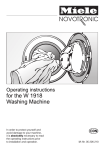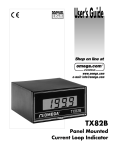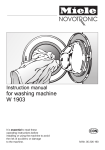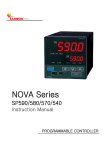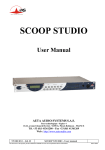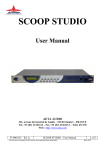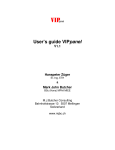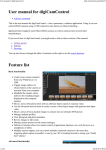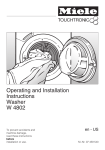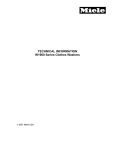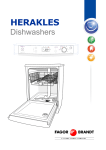Download Miele W 1930 WASHING MACHINE - OPERATING Operating instructions
Transcript
Operating instructions for the W 1930 Washing Machine In order to protect yourself and avoid damage to your machine, it is absolutely necessary to read the operating instructions prior to installation and operation. ] M.-Nr. 05 226 250 Contents Contents Guide to the machine. . . . . . . . . . . . . . . . . . . . . . . . . . . . . . . . . . . . . . . . . . . . . . . 3 Important safety instructions . . . . . . . . . . . . . . . . . . . . . . . . . . . . . . . . . . . . . . . . 5 Preparation for use Help protect our environment . . . . . . . . . . . . . . . . . . . . . . . . . . . . . . . . . . . . . . . . . 6 Economical usage . . . . . . . . . . . . . . . . . . . . . . . . . . . . . . . . . . . . . . . . . . . . . . . . . . 7 Preparing the Laundry . . . . . . . . . . . . . . . . . . . . . . . . . . . . . . . . . . . . . . . . . . . . . . . 8 End of programme . . . . . . . . . . . . . . . . . . . . . . . . . . . . . . . . . . . . . . . . . . . . . . . . . 10 Changing the programme sequence. . . . . . . . . . . . . . . . . . . . . . . . . . . . . . . . . . . 11 Adding detergent . . . . . . . . . . . . . . . . . . . . . . . . . . . . . . . . . . . . . . . . . . . . . . . . . . 12 Adding fabric softener or starch . . . . . . . . . . . . . . . . . . . . . . . . . . . . . . . . . . . . . . 13 Programmes. . . . . . . . . . . . . . . . . . . . . . . . . . . . . . . . . . . . . . . . . . . . . . . . . . . . . . 14 Textile care symbols. . . . . . . . . . . . . . . . . . . . . . . . . . . . . . . . . . . . . . . . . . . . . . . . 19 Additional options . . . . . . . . . . . . . . . . . . . . . . . . . . . . . . . . . . . . . . . . . . . . . . . . . 20 Delay start/Time remaining indicator . . . . . . . . . . . . . . . . . . . . . . . . . . . . . . . . . . . 21 Programmable functions . . . . . . . . . . . . . . . . . . . . . . . . . . . . . . . . . . . . . . . . . . . . 22 USER MAINTENANCE Instructions Cleaning and care . . . . . . . . . . . . . . . . . . . . . . . . . . . . . . . . . . . . . . . . . . . . . . . . . 27 Problem solving guide . . . . . . . . . . . . . . . . . . . . . . . . . . . . . . . . . . . . . . . . . . . . . . 31 After sales service . . . . . . . . . . . . . . . . . . . . . . . . . . . . . . . . . . . . . . . . . . . . . . . . . 37 INSTALLATION INSTRUCTIONS . . . . . . . . . . . . . . . . . . . . . . . . . . . . . . . . . . . . . 38 Plumbing . . . . . . . . . . . . . . . . . . . . . . . . . . . . . . . . . . . . . . . . . . . . . . . . . . . . . . . . 44 Electrical connection . . . . . . . . . . . . . . . . . . . . . . . . . . . . . . . . . . . . . . . . . . . . . . . 45 Technical data. . . . . . . . . . . . . . . . . . . . . . . . . . . . . . . . . . . . . . . . . . . . . . . . . . . . 47 2 Guide to the machine Guide to the machine 1 Electric supply cable 6 Drum door 2 High pressure inlet hoses 7 Access panel for drain pump and filter 3 Flexible drain hose, with detachable swivel elbow 8 Four height adjustable feet 9 Emergency door release and drainage 4 Detergent dispenser drawer 5 Facia panel with controls 3 Guide to the machine Detergent dispenser drawer Compartment i - for the pre-wash. Compartment j - for the main wash. Compartment p (with lid) - for fabric softener or starch. b c d “Delay start” button. e “ON/OFF” button; to turn machine on or off or to interrupt a programme. The “On” lamp illuminates. 4 Time display “h mins”. “Door” button; opens the drum door. f g h Pushbuttons for additional functions. i Programme SELECTOR switch. SPIN SPEED SETTING switch. PROGRAMME SEQUENCE indicators (LED indicator lamps). Important safety instructions Important safety instructions WARNING – To reduce the risk of fire, electric shock, or injury to persons when using your appliance, follow basic precautions, including the following: 1. Read all instructions before using the appliance. 2. Do not wash articles that have been previously cleaned in, washed in or soaked in gasoline, dry-cleaning solvents, or other flammable or explosive substances. They give off vapors that could ignite or explode. 3. Do not allow children to play on or in the appliance. Close supervision is necessary when the appliance is used near children. 4. Before the appliance is removed from service or discarded, remove the door to the washing compartment. 5. Do not reach into the appliance if the drum is moving. 6. Do not install or store this appliance where it will be exposed to weather. 9. Do not add gasoline, dry-cleaning solvents, or other flammable or explosive substances to the wash water. These substances give off vapors that could ignite or explode. 10. Under certain conditions, hydrogen gas may be produced in a hot water system that has not been used for 2 weeks or more. HYDROGEN GAS IS EXPLOSIVE. If the hot water system has not been used for such a period, before using the washing machine, turn on all hot water faucets and let the water flow from each for several minutes. This will release any accumulated hydrogen gas. As the gas is flammable, do not smoke or use an open flame during this time. SAVE THESE INSTRUCTIONS Refer to the Electrical Connection Section for grounding and installation instructions. 7. Do not tamper with the controls. 8. Do not repair or replace any part of the appliance, or attempt any servicing unless specifically recommended in the user-maintenance instructions or in published userrepair instructions that you understand and have the skills to carry out. 5 Help protect our environment Help protect our environment Warning - To reduce the risk of fire, electric shock, or injury to persons, read the IMPORTANT SAFETY INSTRUCTIONS before operating this appliance. Disposal of the packing material The transport and protective packing is mostly manufactured from the following recycled or recyclable materials: – corrugated paper/cardboard – polystyrene - CFC-free – polystyrene foil (transparent) – Untreated wood – Polypropylene (PP) strapping Rather than throwing these materials away, please take them to your community recycling center. 6 Disposal of your old machine Old machines contain materials which can be recycled. Please contact your recycling center or scrap merchant before disposing of the appliance. Economical usage Economical usage The key to good wash results is finding the correct combination of detergent and temperature, and then allowing the washing machine to optimize their usage through its programming. Programme lengths can vary for this reason. With the “Hydromatic” system, the drum can revolve at various speeds. Faster and slower agitation speeds, along with pauses for soaking, combine to ensure excellent results. The automatic load control feature ensures the correct water level for the type of fabric and load being washed (even though it may appear as if there is too little water in the drum!). Because of the accurately balanced drum and special sound insulation, machine noise is minimal while operating. The fully electronic controls offer a combination of simple operation with many optional features. Economy For optimum economical usage, remember the following tips: – The automatic load control feature will adjust the water level for loads between 1 and 5 kg. However, if possible, load the machine to its maximum capacity in order to use water and energy to the best advantage. – Use only the correct amount of detergent required for the water hardness in your area. Miele recommends the use of low-sudsing detergents, as their characteristics allow them to perform better in front-loading machine than regular powder or liquid detergents. If the wash is not heavily stained, select a lower temperature than indicated on the wash care label. For instance, since a main wash generally gives good results for a normal load, the pre-wash cycle has been made a user selectable option, saving time,water and energy over older full cycle machines. 7 Preparing the Laundry Preparing the Laundry The headings numbered (1,2,3,...) show the operating sequence and can be used as a brief guide. Before washing 1 Prepare the wash load Most garments have a textile care label in the collar or side seam. Sort the laundry by care label and color. Only wash items that are labeled machine washable by the manufacturer. Dark fabrics often contain “excess dye” and should be washed separately several times before being included in a mixed load. Delicate fabrics should be washed separately using a delicates programme. Only wash wool or wool mixtures if they are labeled machine washable on the textile care label. Pre-treat the laundry Empty all pockets. Foreign objects inadvertently left in pockets (e.g. nails, coins, paper clips, etc.) can cause damage to clothes and the machine. Damage to the machine can occur if wires from underwire bras come loose. Do not wash underwire bras in the machine without ensuring that wires are secure. Sort the laundry 8 Badly soiled areas (e.g. collars and cuffs) and water soluble stains can be pre-treated with bar soap, stain remover, or detergent mixed into a solution or paste. Do not use detergents containing solvents in the machine. Preparing the Laundry 2 Press the “Door” button to open the door 3 Load the machine Unfold the laundry and place it in the drum. For best results we recommend washing mixed loads consisting of both large and small items. This improves the washing effectiveness and helps distribute the load evenly to keep the machine stable and reduce noise during spinning. Recommended load sizes are noted below: COTTONS . . . . . . . . . . . . . . . . . . 5.0 kg PERMANENT PRESS . . . . . . . . . 2.5 kg To start a programme 1 Turn the programme selector to Start / Finish 2 Press the “ON/OFF” button 3 Press any additional option buttons desired (See the “Delay start” section if this feature is desired.) 4 Select spin cycle speed 5 Turn the programme selector to the desired programme The programme selector can be turned to the left or the right. DELICATES . . . . . . . . . . . . . . . . . 1.0 kg HANDWASH/WOOLLENS . . . . . . 1.5 kg Rinse . . . . . . . . . . . . . . . . . . . . . . 5.0 kg With curtains: Remove lead weights and strips and place in a laundry bag. Woollens and knitted garments should be turned inside out if recommended by the manufacturer. 4 Close the machine door Make sure there are no clothes caught between the drum door and seal. 5 Add detergent See section “Adding detergent” for details. 9 End of programme End of programme After washing 1 Turn the programme selector switch to “Start/Finish” 2 3 Press the “ON/OFF” button. 4 Remove the wash. 5 Check the folds in the door seal for any small articles such as buttons or nails which may be lodged there. Press the “Door” button. Do not attempt to remove laundry from the machine if the drum is turning. You may seriously injure yourself. If the drum turns with the door open, contact the Miele Service Department. Make sure the drum is empty by manually turning it completely around or, during the next use, items may be damaged (e.g. shrink) or cause other laundry to discolor. 6 10 Close the drum door. Changing the programme sequence Changing the programme sequence To cancel a programme: Turn the programme selector to “Start/Finish”. To interrupt a programme: Press the “ON/OFF” buttton. To continue the programme, turn the machine back on. To change an incorrectly selected programme: To omit a programme stage: A programme stage must first be reached to be omitted: Turn the programme selector to “Start/Finish” As soon as the PROGRAMME SEQUENCE indicator lamp for the stage you wish starts flashing: Turn the programme selector switch to the desired programme. Turn the programme selector switch to “Start/Finish”. When only the “On” lamp is lit, a new programme can be selected. To change a programme which has been “locked” using the Child Safety feature, see the “programmable functions” section. 11 Adding detergent Adding detergent Detergent should be added to compartment j at the beginning of each wash cycle. Miele recommends the use of low-sudsing detergents, as their characteristics allow them to perform better in frontloading machines than regular powder or liquid detergents. It is important to add the correct amount of detergent, because... ...too little detergent can result in: – grey laundry – grease/stains not being removed Due to the Miele “Eco-System”, approximately 2/3 of the manufacturer’s recommended amount of detergent is generally sufficient for excellent wash results. – lime deposits on the heater elements and drum. If you have difficulty finding a low-sudsing detergent, contact Miele Limited. – excessive foam Do not use chlorine bleach! Chlorine bleach will damage the machine. – poor cleaning and rinsing results. ...too much detergent can result in: – low level of agitation Water Softeners For extremely hard water: Water is taken in through compartment j in the main wash. If your water is extremely hard (above 400 ppm CaCO3) and the capacity of compartment j is insufficient for the amount of detergent needed, a Service Technician can reprogramme the machine so that water and detergent can also be taken in through compartment i. For small loads: – Gradually reduce the amount of detergent used with each small load. – Check the wash results and the condition of the laundry. – If the laundry is not clean or if it is grey or hard to the touch, add slightly more detergent the next time you use the machine. 12 If you wish to use a water softener to cut down on detergent usage in hard water areas: – add the amount of detergent necessary for a soft water area. – Following the manufacturer’s recommendations,add the specified amount of water softener. Always add the detergent first, in compartments i and j followed by the softener, to ensure that both are properly dispensed. Adding fabric softener or starch Adding fabric softener or starch If fabric softener is desired, it will work more effectively and be gentler on the clothes if it is dispensed in the final rinse cycle of the wash, rather than in the tumble dryer through the use of softener sheets. To automatically dispense fabric softener: Open the lid of compartment p. At the end of the programme a small amount of water will normally remain in compartment p. A high water level in this compartment, however, may indicate that the siphon is clogged or the dispenser drawer was opened during the last rinse cycle, thereby interrupting the distribution of fabric softener. In this case, the siphon tube should be cleaned as described on Page 21. Starch If starch is used for shirts, blouses, table cloths, napkins, etc., pour the liquid starch into compartment p (use the some procedure as for fabric softener). Never mix fabric softener and starch together in compartment p. This can lead to a blockage in the washer’s overflow system. Following the manufacturer’s recommendations, pour the specified amount of liquid fabric softener into compartment p. However, do not exceed the maximum fill level marked inside the compartment, as any excess will prematurely activate the siphon and be wasted. Close the compartment lid and push in the dispenser drawer. The conditioner will automatically be dispensed during the last rinse cycle. Using the “Starch” programme for dispensing liquid starch – Prepare the starch solution in accordance with the manufacturer’s instructions and pour it into compartment i. – Use the normal water level (Water Plus button “out”) when starching so that the solution will have the maximum effect. “Without final spin” can be selected to reduce fabric creasing. 13 Programmes Programmes The run time of front-loading machines is longer than that for most top-loading, vertical tub machines. This is because front-loading machines balance the 5 basic washing factors (mechanical action, water, detergent, temperature and time) diffently than do vertical tub machines. Miele’s front-loading machines use an advanced hydromatic washing action, precise and steady temperatures, less water and detergent than vertical tub machines but more time. The longer run time is part of the equation that produces Miele’s excellent wash results. COTTONS X = additional options For cotton fabrics without special finishes. For most everyday loads, e.g. sheet, towels, jeans, sweatshirts, tshirts underwear. Temperature guidelines: 1) Water levels used: wash - low rinse - low 60 – 95°C – exclusively white items. 2) Rinse cycles used: Normal programme - four Rapid wash - two 30 – 40°C – dark coloured items. 40 – 50°C – light coloured items. 80°C – e.g. whites. such as socks, which would commonly be bleached in a top-loading, vertical tub machine. 95°C – e.g. diapers. max/load: max/spin: Normal run time: Rapid wash time: 14 5.0 kg (11 lbs.) 1600 rpm 1 h 48 min 1 h 06 min Programmes PERMANENT PRESS X = additional options For cotton blend fabrics, polyester blends and other synthetics such as acrylic, nylon and ramie. Temperature guidelines: 1) Water levels used: wash - low rinse - high (to reduce wrinkling) 40°C – 50°C – light coloured cotton or synthetic items. 2) Rinse cycles used: Normal programme - three Rapid wash - two 30°C – 60°C – dark fabrics which are a blend or 100% synthetic fabrics. white polyester/cottons items. max/load: max/spin: Normal run time: Rapid wash time: 2.0 kg (4.5 lbs.) 900 rpm 1 h 07 min 34 min 15 Programmes DELICATES X = additional options For synthetics, machine washable silks, fine washables commonly washed by hand (e.g. blouses, sweaters, but not wool or wool blends), lace or crocheted (non-woolen) items, curtains and knit garments. Temperature guidelines: 1) Water levels used: wash - high rinse - high 2) Rinse cycles used: Normal programme - three Rapid wash - two cold – 30°C – dark coloured silks and all synthetic items (lingerie) 40 – 50°C – light coloured silks and lace tableclothes. 60°C – white cotton lace and crocheted items. For machine washable curtains, use cold – 30°C with a pre-wash. Load the drum loosely up to 1/3 full. max/load: max/spin: Normal run time: Rapid wash time: 16 1.0 kg (2.2 lbs.) 600 rpm 53 min 32 min Programmes HANDWASH/WOOLLENS / For all machine washable woollens or hand-washable wool or wool blends, including blankets and wool mixtures with cotton or rayon. Also suitable for woollens commonly washed by hand (e.g. sweaters) and silks. 1) Water levels used: wash - low rinse - low 2) Rinse cycles used: Normal programme - two No additional options can be selected in this programme. Reduced agitation is also used. Temperature guidelines: cold – 40°C – for all colours of wool. cold – 30°C – for silk. For satin, lace and silk manually reduce the spin speed to the lowes possible setting, or select “without final spin”. max/load: max/spin: Normal run time: 1.5 kg (3.5 lbs.) 1200 rpm 38 min 17 Programmes Starch Rinse For tablecloths, napkins, aprons, shirts. For hand washed items that can be gently rinsed, and if desired, spun. max/load: max/spin: Normal run time: 1) Water levels used: rinse - high 5.0 kg (11 lbs.) 1600 rpm 18 min 2) Rinse cycles used: Normal programme - two Spin For spinning wet items not washed in the machine (hand washed). Such items must be suitable for machine spinning. max/load: max/spin: Normal run time: max/load: max/spin: Normal run time: NOTE: 5.0 kg (11 lbs.) 1600 rpm 7 min Drain For draining water from the machine when “Without final spin” has been selected as the spin speed so that laundry may be removed wet for drip drying. 18 2.0 kg (4.5 lbs.) 900 rpm 14 min If “cold” is selected in “HANDWASH/WOOLLENS” or “DELICATES” the machine will heat the water to 24°C to help the detergent dissolve and to compensate for temperature fluctuations in the plumbing system. To soak clothing, select one of the programmes “COTTONS”, “PERMANENT PRESS”, “DELICATES” or “HANDWASH/WOOLLENS”; wait for the machine to fill and press the “ON/OFF” button. The machine will turn off. After soaking, select “Drain”. Textile care symbols Textile care symbols The textile care symbols on clothing indicate the maximum temperature at which the clothing should be washed and are a good guideline when choosing a programme. In choosing a programme, it can be taken into account that front-loading machines are gentler on clothing than most top-loading, vertical tub machines. Drying Dry flat (Yellow symbol) Tumble dry low temperature (Green symbol) Tumble dry medium to high temperature Hang to dry Drip dry Do not use chlorine bleach! Chlorine bleach will damage the machine. The following is an explanation of textile care symbols: Washing c h Do not wash / Hand wash in 40°C water 7 Machine wash at 40°C Ironing F J Do not iron G Iron at low setting H Iron at medium setting I Iron at high setting Dry cleaning D Do not dry clean Dry clean Chlorine bleach x Do not use chlorine bleach! Chlorine bleach will damage the machine. 19 Additional options Additional options By selecting one or more pushbutton functions, basic programmes can be tailored to the type of laundry being washed. The “Water plus” option is available in the following programmes: The wash and rinse cycles for COTTONS. The wash cycle for PERMANENT PRESS. “Gentle action” When the “Door” button is pressed, all the other buttons spring out, and the additional options are cancelled. “Pre-wash” Use for heavily soiled or stained laundry items. Available in the “COTTONS”, “PERMANENT PRESS” and “DELICATES” programmes. Add the required amount of powder detergent to compartment i and j. “Water plus” This increases the normal water level to a slightly higher level: for particularly delicate fabrics in addition to the “Gentle wash” option, in hard water areas, if more water is required for dispensing the detergent, In soft water areas to enhance washing and rinsing results. For people who are skin sensitive to detergents. 20 For actioning of lightly soiled items, or delicate fabrics which tend to pill. Drum movement is reduced by half. Available in the “COTTONS”and “PERMANENT PRESS” programmes. “Rapid wash” Offers a quick wash cycle (approx. 38 minutes) Can be used with or without a prewash. To operate: 1 Push in the ON/OFF button to turn on the machine. 2 Push in the Pre-wash button if desired. 3 Push in the Rapid wash button. Notice the thick grey ring surrounding the button. This grey ring corresponds to the grey ring surrounding the COTTONS, PERMANENT PRESS and DELICATES programmes on the Selector switch. As long as the programme selected is within this ring, the actual wash times will be close to what is displayed. 4 Choose the desired programme and the machine will start. Delay start/Time remaining indicator Delay start/Time remaining indicator Time display “H:min” Deleting the start delay The Time display has a dual function. The Delayed start is activated by pressing the button, or; – When the display reaches “9 h 30 min”, press the button to the left of the “Delay start” lamp and the start delay will be deleted. It shows the time remaining in the wash programme. Remaining time Delay Start If the “Delay start” lamp is blinking, the start of the programme can be delayed up to 9 hours and 30 minutes. Entering the start delay: – Press the button to the left of the “Delay start” lamp as many times as necessary until the desired delay time appears. Each time the button is pressed, the time of delay will increase by 30 minutes. The remaining time for programme completion is shown in hours and minutes as soon as: – A programme is selected. – The time delay reaches zero. The display counts backwards in 1 minute increments. Select the programme – The display will begin counting the delayed time backwards in one minute increments.The “Delay start” lamp will remain lit. Programme start – When the delay time reaches zero, the “Time remaining” lamp illuminates, and the “Delay start” lamp goes out. The duration of the selected programme will be shown on the display. 21 Programmable functions Programmable functions Warning - To reduce the risk of fire, electric shock, or injury to persons, read the IMPORTANT SAFETY INSTRUCTIONS before operating this appliance. vated, but the programme will continue uninterrupted. This prevents children from inadvertently changing or stopping a wash programme by playing with the dials. Additional functions can be programmed into the machine if desired: If the programme selector switch is turned to its original position, the “On” lamp will stop flashing. A High water level (only in To change a programme once the programme lock is activated: “Cottons” rinses) Where rinse results are particularly important (e.g. Soap allergies). B 5th Rinse in the “Cottons” programme For soft water areas (up to 135 ppm calcium carbonate). In soft water areas, a higher water level can be selected in addition to a 5th rinse cycle, if required. C No water intake through compartment i The 10 second water intake through compartment i during the main wash is omitted. D Programme lock (Child safety feature) When activated, the washing machine will ignore any changes made after the first three minutes of operation. For example if the programme selector switch is moved to a different setting or an additional function is selected, the “On” lamp will flash, notifying you that the Child safety feature has been acti22 Turn the programme selector switch to “Start/Finish”. The PROGRAMME SEQUENCE indicator lamps will start flashing in succession after about 30 seconds. A new programme can be selected as soon as the “On” lamp is the only one remaining lit. The functions described above can be programmed by the Customer using the steps shown on the following pages. There are other programmable functions which are reserved for Miele Service Engineers. They are not normally activated, and require access to internal machine components. E Additional rinse in Rapid wash For soft water areas. For an extra thorough rinse. Programmable functions Step 1: Turn off the machine, close the door, and release all pushbuttons. Set the progam selector switch to “Start/Finish”. Step 2: Carry out steps 2 and 3 within 4 seconds. Press the “ON/OFF” button Step 3: Press the “Water plus” button 4 times (i.e. press in and out twice) The “ON” lamp will illuminate and the “Prewash” and “Main wash” lamps will flash. 23 Programmable functions Step 4: Select the function desired: Desired function: A High water level Set the programme selector to “Rinse”. Continue with Step 5 to activate. B 5th rinse cycle Set the programme selector to “Drain”. Continue with Step 5 to activate. C No water intake Set the programme selector to “Starch”. Continue with Step 5 to activate. through compartment i D Programme lock (Child safety feature) 24 Set the programme selector to “HANDWASH/ WOOLLENS cold”. Continue with Step 5 to activate. Programmable functions E Additional rinse in Rapid wash Set the programme selector to “HANDWASH/WOOLLENS 30°”. Continue with Step 5 to activate. Step 5: activate the function Press the “Water plus” button twice (i.e. in and out once) to toggle the function “ON/OFF”. The “Rinse 1-2” lamp will illuminate when the function is activated. Step 6: to store in memory Press the “ON/OFF” button. 25 Programmable functions To check if the function has been stored: Carry out Steps 1 to 4. If the “Rinse 1-2” lamp lights up, the programmable function is activated. Press the “ON/OFF” button. This finishes the check of the programmable function. If, after Step 2, the selector switch is accidentally turned to a setting other than one of the three shown: – If the “Rinse 1-2” indicator does not light up - no function was activated – If the “Rinse 1-2” indicator lights up - proceed as in “Deleting the additional functions”. Exception: the “Rinse 1-2” indicator will light up if the switch is set to “COTTONS 95°C”. 26 Deleting the additional functions: Follow the same instructions given under “To activate the additional functions”, steps 1 to 4. When the “Rinse 1-2” lamp goes out; Press “ON/OFF”. The additional function has now been deleted. USER MAINTENANCE Cleaning and care USER MAINTENANCE Cleaning and care Cleaning the washing machine Clean the casing with a mild nonabrasive detergent or soap and water Wipe dry with a soft cloth. Clean the control panel with a damp cloth and dry with a soft cloth. The drum can be cleaned using a stainless steel cleaner according to the manufacturer’s instructions. Do not use abrasive cleaners or solvents. Cleaning the detergent drawer. Should the detergent drawer become clogged or dirty, it can be cleaned as follows: Pull out the drawer until it stops. Clean the dispenser compartments and the fabric softener duct. Remove the siphon tube from compartment p and rinse in warm water. Press down the red release lever and, at the same time, pull the drawer out of the machine. 27 USER MAINTENANCE Cleaning and care Cleaning the fluff (drain) filter and pump Check the fluff (drain) filter initially after 3-4 washes to ascertain how often it is likely to require cleaning. With normal cleaning approx. 2 litres of water run out. If the drain outlet is clogged, more water will be retained in the machine (up to 25 litres). Caution: If laundry has been washed at a high temperature, water draining out of the machine will still be hot. Open the flap. Place a dish under the drain fixture. Turn the fluff filter lid round 2-3 times. Do not take it right out. Take the (yellow) filter flap opener from behind the detergent drawer facia panel, (see illustration above). Open the door. 28 With large volumes of water, when the dish is full screw the fluff filter back into position, and empty the dish before repeating the procedure. USER MAINTENANCE Cleaning and care Once the flow of water ceases, remove the fluff filter completely. Clean the fluff filter thoroughly. Turn the impeller by hand to check that it is free to rotate. Any foreign objects causing an obstruction should be removed. Remove any foreign objects (e.g. buttons, coins, etc.) and fluff. Clean the inside of the fluff filter housing. Remove any deposits of lime scale and detergent or foreign objects from the thread of the filter housing and filter unit (as these objects can cause a leakage of water). Deposits of limescale are often a sign of underdosage of powder. Put the fluff filter back in place and secure. After performing this action gently pour approx. 2 litres of water into the detergent dispenser compartment j to reactivate the ball valve which keeps detergent in circulation in the suds. 29 USER MAINTENANCE Cleaning and care Cleaning the filter in the water inlet (First turn off the stopcock). The washing machine has two inlet filters to protect the inlet valves. – in the open end of the inlet hose. – in the inlet connection between the hose and the machine, only to be cleaned by a Service engineer. To clean the filter in the inlet hose: Turn off the valve. Carefully unscrew the inlet hose from the valve by turning the connector counterclockwise using a wrench if necessary. Remove the rubber seal from the connector. The filter in the inlet hose should be cleaned about every six months, or after an interruption to the external water supply. Using needle nose pliers, grasp the plastic filter and pull it out of the hose connector. Clean the filter under running water and carefully remove any large particles. Replace the filter and seal and reconnect the hose. Slowly turn on the valve and check for leaks. 30 Problem solving guide Problem solving guide Any work done on the electrical components of this appliance should only be performed by a qualified and trained person in accordance with all local and national codes and regulations. Unauthorized repairs may result in personal injury and damage to the machine. What to do if, . . . Cause . . . Remedy . . . . . . The programme does not start? There is no power. The “ON” indicator lamp has not lit up. Check that..: There is power and the “ON” indicator lamp is on, but the programme selector has not been turned to the “Start/Finish” position. – Turn the programme selector The “Check p” indicator lamp is flashing, and the programme has started. The water inlet is blocked. – The inlet valve is not opened The “Check q” indicator lamp is flashing. The drain is blocked. – Clean the drain pump and – the door is properly closed. – the machine is plugged in. – the fuse or circuit breaker has not tripped. . . . The “Check p / q” indicator lamps are flashing? to the “Start/Finish” position. – Select a programme. far enough. – The inlet hose is kinked. – The water pressure is too low. Call the Service Dept. lint trap. – Has the drain hose been installed too high? (max drain height = 4 feet) 31 Problem solving guide What to do if, . . . Cause . . . Remedy . . . . . . the “Pre-wash”, “Main wash” or “Rinse 1-2” indicator lamp is flashing? There is an internal problem. Restart the programme. If the indicator lamp starts flashing again, call the Service Dept. . . . The “Rinse & hold” indicator lamp is flashing? The spin speed setting has been set to “Without final spin”. Select a spin speed setting. . . . The “Final spin” indicator lamp is flashing? The final spin has not taken place. The machine detected an imbalance. – Redistribute the laundry load. – Select a spin speed. – Turn the programme selector . . . The “ON” indicator lamp is flashing? The child-safety feature is activated, and the programme has been changed. . . . The wash is too wet after the final spin? The spin speed selected was too low. Select a higher spin speed next time. The load was not evenly distributed in the drum, and the laundry was spun at a reduced speed to protect the machine. The drain pump or lint trap is clogged. The four feet are not resting evenly on the floor. The shipping struts have not been removed. Mix large and small items in a load to avoid imbalance. . . . The machine shakes during the spin cycle? 32 to “Spin”. Go back to the programme originally selected. Clean the drain pump or lint trap. Level the machine (see Installation Section). Remove the shipping struts. Problem solving guide What to do if, . . . Cause . . . Remedy . . . . . . In spite of adequate water supply, the water flows slowly into the machine? A filter in the water inlet system is blocked. Clean the water inlet filters. . . . Large residues of detergent remain in the dispenser drawer? The water pressure is too low. – Clean the filters in the water inlet system. – It may help to select “Water plus”. Detergent used with a water Pour detergent into the softener tends to become sticky. dispenser before adding any water softener. . . Fabric softener is not completely dispensed or water remains in the p compartment? . . . There is an excessive build-up of foam? The dispenser drawer was not pushed in when the fabric softener was being dispensed. Make sure the drawer is all the way in. The siphon tube is either incorrectly positioned or clogged. Use only a low-sudsing detergent at the appropriate temperature. Clean the siphon tube. – Follow recommendations on the package. – Take the water hardness into account. – Use less detergent for lightly soiled or small loads. . . . Lime deposits appear on the drum surface? Not enough detergent has been used. – Use a decalcifier suitable for – use in washing machines. A product called “Quick” is available from the Miele Parts Department. Use the correct amount of detergent for the water hardness in your area. 33 Problem solving guide What to do if, . . . Cause . . . Remedy . . . . . . Grey greasy particles cling to washed laundry? Insufficient detergent was used to break down the particles of grease in heavily soiled laundry. – Add more detergent. – Before washing the next load Liquid detergents do not contain bleaching agents. They do not remove stains as well as powdered detergents containing non-chlorinated bleaches. – Use a general purpose This is a normal occurance of everyday wear with some fabrics. These fabrics must be handled with care. Wash them using the DELICATES programme and/or select “Gentle wash” in the future. . . . Liquid detergent does not give the required result? . . . After washing pilling appears on the fabric? 34 run a COTTONS 50°C programme with detergent but without a load to clean the machine. powder detergent containing a bleaching agent. – Pre-treat stains with a stain remover. Problem solving guide Opening the drum door in the event of a power failure Switch off the washing machine. Remove the flap opener from behind the detergent drawer facia panel. Place a dish or bowl under the spout. Point the drain hose into the container. Remove the stopper. Caution: if laundry has been washed at a high temperature water draining out of the machine will still be hot! The amount of water discharged depends on the drainage height. A delivery head (e.g. 1 m) will mean there is more water to drain. The container will need to be emptied several times. When no more water drains out place the stopper back in the hose. Open the flap (in the machine plinth). 35 Problem solving guide To check water pressure Place a bucket under the water supply valve. Turn on the valve. If 5 litres of water flow into the bucket in 15 seconds the water pressure is correct. Electric socket If there is any doubt about the electricity supply socket, consult a qualified electrician. Pull the emergency door latch downwards using a spoon handle (see illustration). The machine door will then open. Please note that: on machines with left hand hinging the emergency door latch is located behind a second access flap in the centre of the plinth. Always make sure the drum is stationary before reaching in to the machine to remove washing. Reaching into a moving drum is extremely dangerous. 36 After sales service After sales service If problems occur that cannot be easily remedied, or if the appliance is under warranty, please contact: – Your Miele Dealer or – The Miele Service Department (see back cover). When contacting the Service Department, please have the model and serial numbers of your appliance available, both of which can be found on the dataplate visible above the front glass on the inside of the door. 37 INSTALLATION INSTRUCTIONS INSTALLATION INSTRUCTIONS Installation surface Removing the shipping struts Experience has shown that a concrete floor is the most suitable surface for a washing machine. Concrete floors are far less prone to vibration during the spin cycle than wooden floors. Please note the following points: The machine must be level and securely positioned. To avoid vibrations during spinning, the machine should not be installed on soft floor coverings. If installation must be on a wooden joist floor, we recommend the use of a plywood base at least 3 cm thick and 60 x 60 cm wide. Ideally the base should be large enough to span several joists and should be anchored to the joists and not just the floorboards. Turn the left-side shipping strut 90° counterclockwise. As a general rule, we recommend the installation of the machine (or washer/dryer stack) in the corner of a room where the stability of the floor is at its greatest. Installation Lift the machine from its shipping pallet and move it to the installation site. Please note: Do not lift the machine by the drum door. Ensure that the machine feet and the floor are dry to prevent slippage during the spin cycle. 38 Turn the right-side shipping strut 90° clockwise. INSTALLATION INSTRUCTIONS Withdraw the two struts together with the support plate. Plug the two holes with the plastic caps supplied. The machine should not be moved without the transit struts in place. The transit fitting should be stored in a safe place for future use. It must be reinstalled before the machine moved. Reinstallation can be carried out by reversing the procedure. 39 INSTALLATION INSTRUCTIONS Levelling the machine To ensure smooth operation, it is essential that the machine is level. Take care not to injure yourself or damage any surrounding furniture. Failure to level the machine can result in the machine “banging” in the spin cycle or “walking” across the floor during operaton. Energy and water use will also increase. Adjust the four leveling feet as follows: Loosen the conternuts (item #2) on all four legs by moving the handle of the screwdriver to the left (see illustration). Adjust the right rear leg to the proper length. Use the screwdriver to turn the counternut up until it is tight against the bottom tray. Move the machine to its location. BEWARE: The washing machine is heavier than it looks! When working with the machine, be careful that it does not slip or slide along the floor. 40 Shorten the front left leg so the machine is standing on the other three legs only. Push the top front left corner diagonally to ensure that the right rear leg is resting on the floor. Check with a level in both planes as shown in the illustration. To tilt the machine toward the back, extend the right front leg by turning the leg to the left (see item #1). To tilt sideways, shorten or extend the left rear leg. Check with a level again in both planes. If still not level, repeat the adjustment. When the position is correct, use the screwdriver (move the handle to the right) to turn the counternuts up on the right front and left rear legs until they are tight. Extend the left front leg until it is in contact with the floor. Add 1/2 turn rotation. INSTALLATION INSTRUCTIONS Try to rock the machine diagonally to find which diagonal is firmer. If the diagonal from front left to rear right is less firm, extend the front left leg. Adjust only the front left leg until both diagonals have the same stiffness. When finished, turn and lock the counternut on the front left leg. Building under All four counternuts must be tight against the bottom of the machine. In addition, check to see that the legs were not inadvertently unscrewed while tightening the counternuts. Running a machine that is not level or whose legs are not tight may cause damage to both the machine and its surrounding area. Connections for electricity, water and drainage should be installed in such a way that they remain accessible when the machine is in place. When building this appliance under a (continuous) countertop, ensure that the machine has at least a 6 mm (1/4 inch) clearance. If it touches the cabinetry it may be noisy. As well, the top machine cover may be removed if desired. If a countertop is placed over the washer, at least a 6 mm (1/4")gap must be left between the top of the machine and bottom of the countertop; and nothing should be within 12 mm (1/2") of any other side of the washing machine. 41 INSTALLATION INSTRUCTIONS Washer and Dryer stack A Miele tumble dryer can be stacked with the washing machine. A stacking kit* is necessary and can be purchased from the Miele Spare Parts Department. Unscrew the remaining 7 screws from lower and side decor strips until the decor panel bows slightly and can then be taken out or put in place. Re-assemble in the reverse order and tighten the screws. Decor panel dimensions All parts marked* are available from the Miele Spare Parts or Sales Department, and must be fitted by a suitably competent person according to the instructions supplied with the kit. Fitting or changing the decor panel Note: The door should be shut for fitting or changing the decor panel. Remove the 4 screws from the decor strip on the door catch side of the door and remove the decor strip. 42 (The figures given in brackets indicate the tolerance level in mm.) Panelthickness 1 mm to 1,5 mm width height 587 (-1) mm 602 (-1,5)mm Panelthickness 1,6 mm to 4 mm 587 (-1) mm 596,5 (-1,5) mm Panels more than 1.5 mm thick require an "adapter strip for a 4 mm thick decor panel". This is available from your Miele Dealer or the Spare Parts Department (part # 3763550). INSTALLATION INSTRUCTIONS Any residual water left in the machine from the factory testing process can be flushed out as follows: Do not put any laundry in the machine. Water hardness reminder The amount of detergent needed to wash clothes depends on various factors, including the water hardness in your area. You can set the water hardness dial in the detergent dispenser as a reminder. Add a small amount of detergent to compartment j. Turn on the machine. Press the “Rapid wash” button. Turn the programme selector to the “COTTONS 60°C” programme. Any residual water will be flushed out during the programme. Turn the dial to the desired setting. Use the tool supplied with the machine. It is located behind the detergent drawer, on the left hand side (see Cleaning and Care) water. 1 = soft, 4 = very hard 43 Plumbing Plumbing Connect the cold water supply hose (marked blue) to the cold water tap and the warm water supply hose (marked red) to the warm water tap. Turn on taps and check for leakage. The water pressure must be within the 0.1-1 MPa (14 – 140 psi) range. If the water pressure is greater than 1 Mpa (140 psi), a reducer valve must be fitted. At pressures below 0.1 Mpa (14 psi), the standard inlet valve of the machine must be exchanged for a low pressure version by an authorized Miele Service Technician. The water supply hoses are equipped with a strainer filter; please do not remove this filter. Special note If the machine is not to be connected to a hot water supply, it is essential that the hot water inlet hose is also connected to the cold water supply, using a Y connector. Otherwise correct functioning of the machine could be impeded. It is not allowed to connect the machine to a hot water supply only, for functional and safety reasons. 44 Connection to the drainage system The 1.5 m hooked drain hose may be connected as follows: 1. Directly into a sink: hook the hose securely over the edge and secure, e.g. by tying the hose to the water tap. 2. Connection to a drain pipe: fit drain hose into a 38 mm ( 1 1/2") pipe and secure firmly. (An antisiphoning device is not required.) 3. Drainage into floor gully: if required, the drain hose may be extended to 5 m (15 ft.) maximum. The machine drains via a pump with a maximum delivery head of 1.2 m (4 ft.). The hose must not be kinked as this restricts drainage. Electrical connection Electrical connection GROUNDING INSTRUCTIONS This appliance must be grounded. In the event of a malfunction or breakdown, grounding will reduce the risk of electric shock by providing a path of least resistance for the electric current. This appliance is equipped with a cord having an equipment grounding conductor and plug. The plug must be plugged into an appropriate outlet that is properly installed and grounded in accordance with all local codes and ordinances. Warning Improper connection of the equipment-grounding conductor can result in the risk of electric shock. Check with a qualified electrician or serviceman if you are in doubt as to whether the appliance is properly grounded. Do not modify the plug provided with the appliance; if it will not fit the outlet, have a proper outlet installed by a qualified electrician. ELECTRICAL CONNECTION The washing machine comes supplied with a 1.5 m (5 ft.) long, 12/4 AWG cord with a 4 wire, 3 pole grounding plug. (NEMA 14-30P regular Canadian dryer plug). It is ready for connection to a 120V/240V (208V), two phase, 60Hz power supply. The proper outlet can be purchased from any electrical supply dealer. Ask for a NEMA 14-30R receptacle. (See Canadian Electrical Code, Part I, CSA Configurations for NonLocking Receptacles.) 45 Electrical connection “DOUBLE RECEPTACLE” Miele offers a “Double Receptacle” which will allow you to use a standard dryer, 4 wire, 30A outlet that most laundry rooms already have. Two 15A Miele appliances can be powered from this kit. For more infomation on the “Double Receptacle”, please contact – your Miele dealer or – the Miele Service Department. 46 Technical data Technical data 1.1 Dimensions Height 850 mm Width 595 mm Depth (including distance from wall) 610 mm Depth with open door 1180 mm Weight 103 kg Capacity 5 kg dry laundry Rated load 2.8 kW Fuse rating 15 Amp Water pressure 14-140 psi (0.1-1 MPa) Maximum drain height 1.25 m Drain hose diameter 25 mm Maximum drain length 5.0 m Power supply 120 V/240 V ~2 phase 60 Hz (208V) Max floor load 164 kg (360 lbs) 47 Technical data 1.2 Specifications Hot and cold water connection via “Pipe to hose connector” (Female hose thread x 3/4" BSP male pipe thread). Drainage is via 1.5m (5 ft) long, 1 1/4" OD hose (included). Electrical: 1.5m (5 ft) long cable with plug for connection to a two phase 120/240 V (208 V) VAC 60 Hz power supply (3-pole-4 wire grounding). Power consumption: (extended cycles): Cottons without prewash 95°C 1.30 kWh Rapid wash - Cottons (3.2 kg) 60°C 0.25 kWh Water consumption: Cottons without prewash 65 l Rapid wash - Cottons (3.2 kg) 55 l Programme duration Cottons without prewash 95°C 108 minutes Rapid wash - Cottons (3.2 kg) 60°C 38 minutes Spin speed W 1930 from 400 to 1600 rpm Detergent dispenser: Automatic for: Prewash Mainwash Fabric softener or starch Temperature control variable: 48 from cold to 95°C 49 50 51 Alteration rights reserved/000 0699 This paper is made from 100% chlorine-free bleached cellulose and therefore protects the environment.




















































